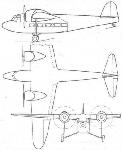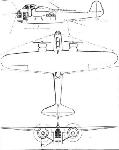
Описание
Страна : Нидерланды
Год : 1935
Twin-engined high-performance commercial monoplane
Koolhoven FK 50
FK 50 представлял собой легкий транспортный самолет, рассчитанный на 8 пассажиров и был спроектирован под требования швейцарской компании "Alpar". Первый из двух FK 50 поднялся в воздух 18 сентября 1935 года, он получил регистрацию PH-AKX, затем был передан Швейцарии, где получил новую регистрацию - HB-AMI. Второй самолет в марте 1936 года был зарегистрирован как PH-AKZ, а после передачи швейцарской компании стал обозначаться HB-AMO.
FK 50 представлял собой моноплан с высокорасположенным крылом, кабиной на двух членов экипажа, неубирающимся шасси с достаточно широкой колеей и силовой установкой с двумя звездообразными двигателями Pratt & Whitney Wasp Junior IIB мощностью по 406 л.с. Максимальная скорость самолета на уровне моря составляла 295 км/ч, максимальная взлетная масса - 4250 кг, размах крыла - 17,70 м, а длина - 14,30 м.
Оба самолета эксплуатировались на регулярных авиалиниях между швейцарскими городами и французскими городами Лион и Марсель, а также на чартерных рейсах в Лондон и Париж. В 1938 году к ним присоединился третий самолет со швейцарской регистрацией HB-AMA (изначально была голландская PH-ASI), отличавшийся перепроектированным хвостовым оперением с двумя килями и рулями направления. Три этих самолета работали весьма активно и успешно, причем одна машина оставалась в эксплуатации вплоть до своего крушения в 1962 году.
Рассматривалась возможность создания на базе самолета бомбардировочного варианта FK 50B, но эти планы реализованы не были.
Описание:
- Koolhoven FK 50
- Flight, August 1936
THREE from ABROAD
Фотографии
-
Мировая Авиация 167
Регистрационный номер: HB-AMI [3] На фотографии - первый самолет типа Koolhoven FK 50, три такие машины эксплуатировались швейцарской компанией "Alpar".
-
Jane's All the World Aircraft 1980 / Encyclopedia of Aviation - Aircraft A-Z - v4
Регистрационный номер: HB-AMI [3] Koolhoven F.K.50.
-
Air-Britain Archive 1983-04
Регистрационный номер: HB-AMO [2] The Koolhoven FK.50 HB-AMO of Alpar which crashed at Waldenberg on 20.9.37.
-
Flight 1935-09 / Flight
A typically varied line-up of machines at Waalhaven In the right-hand lower corner is the new Hornet-engined Koolhoven.
-
Flight 1935-10 / Flight
Регистрационный номер: HB-AMI [3] Despite its somewhat conservative layout "Alpar's" new Koolhoven is a credit to its constructors aerodynamically and structurally
-
Aeroplane Monthly 1990-05 / J.Stroud - Wings of Peace
Регистрационный номер: HB-AMO [2] Alpar's second red and white Koolhoven FK 50, HB-AMO, at Bern.
-
Jane's All the World Aircraft 1938 / 03 - All the world's aeroplanes
The Koolhoven F.K.50 Twin-engined Commercial Monoplane (two 400 h.p. Pratt & Whitney "Wasp-Junior" engine).
-
Aeroplane Monthly 1990-05 / J.Stroud - Wings of Peace
The cabin of one of Alpar's first two FK 50s.
-
Flight 1935-10 / Flight
Perhaps the most striking external features of the new Koolhoven F.K.50 are the cowlings over the Wasp Juniors. They are, supposedly, conducive to a good airflow. The outlook for crew and passengers is exceptionally good.
-
Flight 1936-08 / Flight
The general arrangement of the Koolhoven F.K.50 B bomber.
- Фотографии










